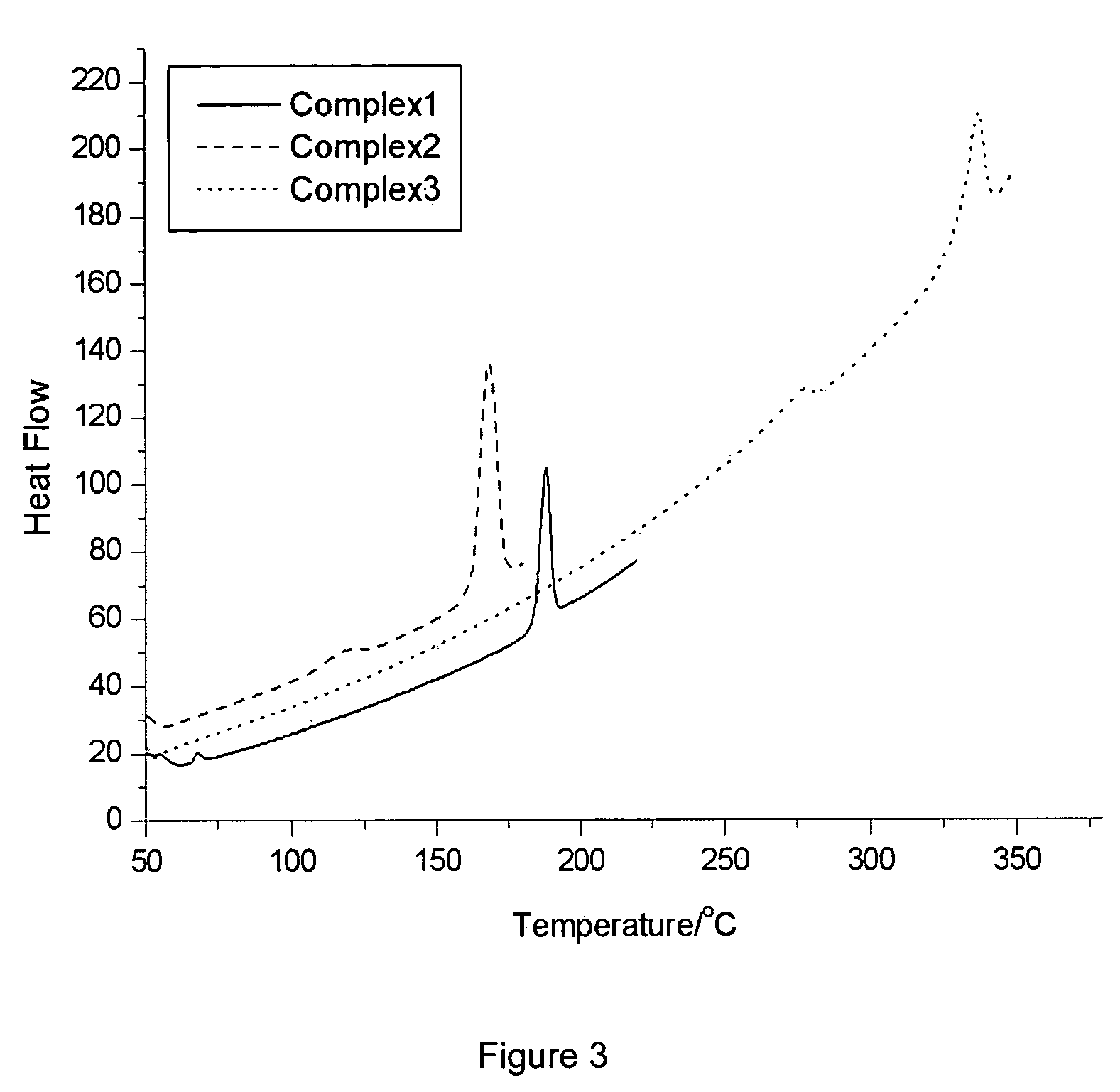Materials for electroluminescent devices
a technology of electroluminescent devices and materials, applied in the direction of luminescnet screens, discharge tubes, natural mineral layered products, etc., can solve the problems of no blue emission from fluorescent or phosphorescent emitters, and only achieve full color displays, so as to improve efficiency and reduce driving voltage , the effect of increasing the efficiency
- Summary
- Abstract
- Description
- Claims
- Application Information
AI Technical Summary
Benefits of technology
Problems solved by technology
Method used
Image
Examples
example 1
Preparation of Compound 2
[0080] Freshly distilled aniline (5 g, 0.055 mole) was introduced into a round-bottom flask containing borane triethylamine compound (9 mL, 0.061 mole) under an argon atmosphere. The mixture was heated to 80° C. for 16 hours, and then further to 180° C. Afterwards, the excess reactant was removed in vacuo. The product was collected upon cooling the reaction mixture to room temperature, and then purified using high vacuum sublimation. White solid (3 g, 53% yield) was obtained. 1H NMR (300 MHz, CDCl3) δ 7.35 (t, J=6.90 Hz, 6H), 7.25-7.18 (m, 9H), 5.00 (bs, 3H) (notes: t=triplet, m=multiplet, b=broad, s=singlet). 13C NMR (75 MHz, CDCl3,) δ 148.0, 128.8, 125.2, 124.7. FAB-MS(m / z): 309 [M+]. M. P. 167° C. (DSC). Tg: 121° C. Td: 203° C.
example 2
Preparation of Compound 3
[0081] Freshly distilled acetonitrile (2 g, 0.048 mole) was introduced into a round-bottom flask containing calcium chloride-dried chlorobenzene under an argon atmosphere. Boron trichloride gas was then continuously bubbled into the solution until fuming is observed above the flask neck, indicating that all acetronitrile was consumed. Dried ammonium chloride powder (2.8 g) was added and the reaction mixture was refluxed for 3 hours. Upon cooling the reaction mixture to room temperature, the chlorobenzene was removed using a cannula. This was followed by the introduction of 150 mL benzene into the reaction mass, and after that the addition of 100 mL a benzene solution of the 15 g (0.088 mole) diphenylamine dropwise to the reaction mixture. The reaction mixture was then refluxed for 16 hours. The white product (4.5 g, 48% yield) was collected with filtration and purified using high vacuum sublimation. FAB-MS(m / z): 582 [M+]. Anal. Calculated for C36H33B3N6: C,...
example 3
[0082] The physical parameters for Compounds 1, 2 and 3 were determined and are summarized in Table 1.
PhysicalCompoundCompoundCompoundParameters123Hole Mobility (cm2 / V · s)up to 10−4up to 10−5up to 1O−5Electron Mobility (cm2 / V · s)up to 10−5up to 10−6up to 10−5Decomposition Temperature227203287(Td, ° C.)Glass Transition Temperature68112278(Tg, ° C.)HOMO (eV)−5.3−5.3*LUMO (eV)−1.0−0.8*Absorption λmax264231* (nm) in DMF solutionEmission λmax288n.o.* (nm) in DMF solution
* = no measurement was made.
n.o. = not observed
PUM
| Property | Measurement | Unit |
|---|---|---|
| Electron mobility | aaaaa | aaaaa |
| Electroluminescence | aaaaa | aaaaa |
| Aromaticity | aaaaa | aaaaa |
Abstract
Description
Claims
Application Information
 Login to View More
Login to View More - R&D
- Intellectual Property
- Life Sciences
- Materials
- Tech Scout
- Unparalleled Data Quality
- Higher Quality Content
- 60% Fewer Hallucinations
Browse by: Latest US Patents, China's latest patents, Technical Efficacy Thesaurus, Application Domain, Technology Topic, Popular Technical Reports.
© 2025 PatSnap. All rights reserved.Legal|Privacy policy|Modern Slavery Act Transparency Statement|Sitemap|About US| Contact US: help@patsnap.com



